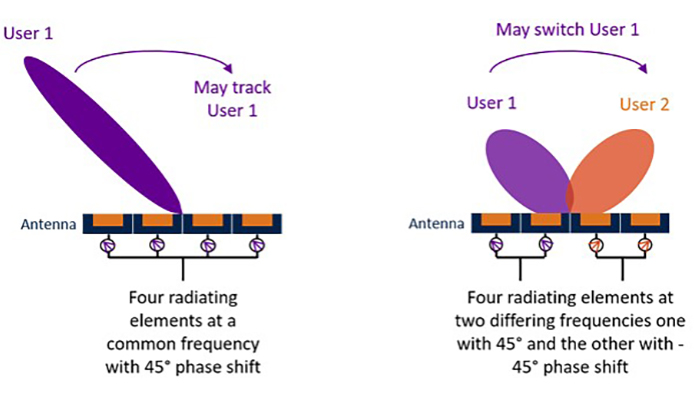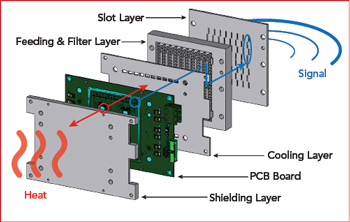5G Millimeter-Wave Antenna Array. In this paper a compact 1 6 antenna array is designed at 28 GHz millimeter wave frequency application with 21 VSWR.

Millimeter Wave Microstrip Antenna Array Design And An Adaptive Algorithm For Future 5g Wireless Communication Systems
Abstract Even though the launch of 5G systems is just around the corner there are a plethora of challenges and.

. IEEE Wireless Communications Issue Date. Developments in beamforming RFICs as well as antenna materials and fabrication techniques has laid the ground work for the implementation of 2D phased arrays for use in a cellular environment. Special Issue Millimeter-Wave Antenna Arrays.
5G Millimeter - Wave Mobile Broadb and. 5G Millimeter-Wave Antenna Array. Of them one example of three-beam metalens antenna operating at 5G New Radio 2-GHz bands is also selected because the design method can be directly extended to the designs at millimeter-wave bands.
Keywords Triband Millimeter-wave antenna 5G Equivalent circuit 1 Introduction et al. When you have long extended nails make sure you at least when try to carry out a design with a molding and most certainly. As there has been an explosive increase in wireless data traffic mmw communication has become one of the most attractive techniques in the 5G mobile communications systems.
Wideband and dual-band support high gain and wide coverage scanning capabilities and small size. Advances in Si-based millimeter-wave circuit design Si-based phased arrays and low-cost antenna integration techniques have enabled the development of scalable phased arrays supporting 10s to 100s of elements. The success in the applications of metantennas has shown the promising way for developing the antennas for new functionalities and new performance.
A low-complexity metallic tapered slot antenna TSA array for millimeter-wave multibeam massive multiple-input multiple-output communication is proposed in this paper. Design and Challenges articleZhang20175GMA title5G Millimeter-Wave Antenna Array. Antenna Array Design Choices Characterization.
Array antenna using a stepped line cut and U-slot combination for 5G millimeter-wave applications is proposed. As we construct the entire antenna there are many challenges of the array design including the routing of control lines power supply management pulsed circuitry thermal management environmental considerations etc. 5g millimeter wave antenna array design and challenges Flowers the preferred ornament from a molding he makes it possible for to make a sublime womanly impression by way of manicure.
Some Challenges in Millimeter Wave Antenna Designs for 5G. Batch download VIEW PDF. IBM TJ Watson Research Centre New York USA.
In addition a lumped element RLC equivalent model of the design is explained and its results are compared with the proposed antenna. 1 July 2022. Scalable Millimeter Wave Phased Arrays.
Design and Challenges authorJing Zhang and Xiaohu Ge and Qiang Li and Mohsen Guizani and Yanxia Zhang journalIEEE Wireless Communications year2017 volume24. Due to the characteristics of high-frequency signal propagation the coverage radius of 5G millimeter-wave cells is usually small and the terminal is prone to interruption of data transmission due to frequent cell switching in the mobile state. An industry view on current issues and challenges Abstract.
1EMC Lab University of Central Florida Orlando FL USA. 2011 various antennas have been proposed exploiting different shaped slots like E-shape F-shape Wireless technology plays. 2EE Department KAU Saudi Arabia.
Antenna Array Design Choices Characterization Rohde Schwarz The next big thing advances in 5G millimeter wave antennas Benchmark Through the 5G Antenna Design Maze with Antenna-plexers Qorvo What is 5G beamforming beam steering and beam switching with massive MIMO Metaswitch Networks. Antennas specification becomes more and more complicated. 5G NR millimeter wave systems are being implemented for commercial applications and show both the promise and challenges of 5G high data rate applications.
The preview is over. Antennas for 5G applications make use of the shorter element sizes at high. Millimeter-wave phased arrays for 5G.
Design Challenges and Applications. Request PDF 5G Millimeter-Wave Antenna Array. Beamforming in 5G mm-Wave antenna arrays.
For 5G networks antenna structuring and designing is an integral part of the communication system. Although mmw communication systems have been successfully applied to indoor scenarios various external. Zhang Jing Ge Xiaohu Li Qiang Guizani Mohsen Zhang Yanxia Journal.
Antennas fabricated with new. Array with new materials. For the impedance matching inset feed is.
The proposed design of millimeter-wave mm-Wave array antenna package with beam steering characteristic for the fifth-generation 5G mobile applications has 10-dB gain in the upper spherical space good directivity and efficiency which is suitable for 5G mobile communications. Deadline for manuscript submissions. The feeding technique used in the proposed design is a proximity coupling technique to improve bandwidth performance.
Millimeter-wave phased arrays for 5G. This special issue belongs to the section Sensor Networks. Implementation of 5G mm-Wave technology requires a lot of significant changes in antenna design engineers work.
Design and Challenges Author. Reddy Design of millimeter wave antenna arrays for 5G cellular applications using FEKO 2016 IEEEACES International Conference on Wireless Information Technology and Systems ICWITS and Applied Computational Electromagnetics ACES Honolulu HI 2016 pp. 5G Millimeter-Wave Antenna Array.
Beamforming in 5G mm-Wave antenna arrays. 5G Millimeter-Wave Antenna Array. Millimeter-wave bands are of increasing interest for the satellite industry and under discussion as potential 5G spectrum.
The proposed design of millimeter-wave mm-Wave array antenna package with beam steering characteristic for the fifth-generation 5G mobile applications has 10-dB gain in the upper spherical space good directivity and efficiency which is suitable for 5G mobile communications. Using Simulation to Overcome Three Millimeter-Wave Design Challenges. In antenna theory improving antenna gain is important to attain isotropic antenna antenna gain can be improved by the controlled behavior of frequencies beam forming and choosing the right antenna fabric.
Large antenna arrays have been always exploited for radar applications in order to provide very high spatial resolution beam-forming and null-steering. Compact Tapered Slot Antenna Array for 5G Millimeter - Wave Massive MIMO Systems. Antenna Array Design Choices Characterization White Paper.
5g Millimeter Wave Antenna Array Design And Challenges. The scope of this Special Issue focuses on technical topics in mmWave antennas that may address but are not limited to the topics below. A special issue of Sensors ISSN 1424-8220.
Raj Mittra 12. New antenna structures MIMO massive-MIMO beamformingbeam steering adaptive array and array with reconfigurable feed network. The second challenge facing 5G millimeter waves is the terminal mobility management problem.
Design and Challenges As there has been an explosive increase in wireless data traffic mmw communication has become one of the most attractive. The antenna efficiency was 424 at 77 GHz.

Pdf High Performance 5g Millimeter Wave Antenna Array For 37 40 Ghz Mobile Application

Challenges Grow For 5g Packages And Modules

Beamforming In 5g Mm Wave Antenna Arrays Radientum
What Is New Gt In Packaging 5g And Mm Wave Packaging News Center

Beamforming In 5g Mm Wave Antenna Arrays Radientum

Mmwave Antennas And Antenna Management For 5g

Comprehensive Survey Of Commercial Mmwave Phased Array Companies 2020 01 15 Microwave Journal
0 comments
Post a Comment